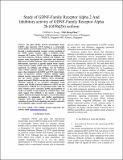Study of GDNF-Family Receptor Alpha 2 And Inhibitory Activity of GDNF-Family Receptor Alpha 2b (GFRα2b) Isoform
Author(s)
Yoong, Li Foong; Too, Heng-Phon
DownloadMEBCS015.pdf (268.7Kb)
Metadata
Show full item recordAbstract
The glial cell-line derived neurotrophic factor (GDNF) and neurturin (NTN) belong to a structurally related family of neurotrophic factors. NTN exerts its effect through a multi-component receptor system consisting of the GDNF family receptor alpha 2 (GFRα2), proto-oncogene RET and/or NCAM. GFRα2 is spliced into at least three isoforms, GFRα2a, GFRα2b and GFRα2c. The present study investigated the expression and functional differences of GFRα2 isoforms. These receptor isoforms are differentially expressed in specific human brain regions. Using Neuro2A model, GDNF and NTN promote neurite outgrowth via GFRα2a and GFRα2c, but not GFRα2b. These GFRα2 isoforms regulate different early response genes when stimulated with GDNF and NTN. Interestingly, using co-expression models, GFRα2b inhibits ligand induced neurites outgrowth of GFRα2a and GFRα2c, and also the related receptor, GFRα1a. More intriguingly, ligands activated GFRα2b was also able to attenuate neurite extension induced by an unrelated stimulation using retinoic acid. MAPK activation induced by GDNF was not attenuated by GFRα2b in a co-expression model, while the early response genes expression profile (up-regulation of FosB) was similar to that induced by GFRα2b alone. This study suggest that GFRα2b is not merely a dominant negative isoform, but signals through a yet to be determined mechanism to antagonize and inhibit neuritogenesis. Together, these data suggest a new paradigm for the regulation of growth factor signaling and neurite outgrowth via an inhibitory splice variant of the receptor.
Date issued
2006-01Series/Report no.
Molecular Engineering of Biological and Chemical Systems (MEBCS)
Keywords
GDNF, NTN, GFR(alpha)2, neurites outgrowth